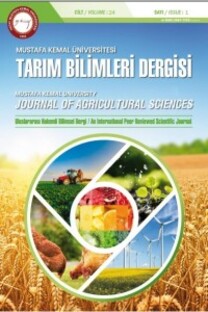Detection of ‘Candidatus Phytoplasma pyri’in different pear tissues and sampling time by PCR-RFLP analyses
Farklı armut dokularında ve örnekleme zamanında ‘Candidatus Phytoplasma pyri’’nin PCR-RFLP analizleri ile saptanması
___
Ahrens U, Seemüller E (1992) Detection of plant pathogenic mycoplasmalike organisms by a polymerase chain reaction that amplifies a sequence of the 16S rRNA gene. Phytopathology 82: 828-832.Bertaccini A, Carraro L, Davies D, Laimer DC, Machado M, Martini M, Paltrinieri S, Seemüller E (2000) Micropropagation of a collection of phytoplasma strains in periwinkle and other host plants p. 101. In: 13th International Congress of IOM 14-19 July Fukuoka Japan.
Canik D, Ertunç F (2007) Ankara ve Yalova İllerindeki Armut Bahçelerinde Görülen Pear Decline Fitoplazma Enfeksiyonunun Moleküler Karakterizasyonu. II. Bitki Koruma Kongresi Isparta s.108.
Çağlayan K, Ulubaş Serçe C, Gazel M (2006) A Preliminary Account of the Presence of Pear Decline Disease (‘Candidatus Phytoplasma pyri’) in Marmara Region of Turkey. XXth International Symposium on Virus and Virus-like Diseases of Temperate Fruit Crops & XI th International Symposium of Small Fruit Virus Diseases Antalya 22-26 May 2006. p.123.
Deng S, Hiruki C (1991) Amplification of 16S rRNA genes from culturable and non culturable mollicutes. J. Microbiol. Methods 14: 53-61.
Errea P, Aguelo V, Hormaza JI (2002) Seasonal variations in detection and transmission of pear decline phytoplasma. J. Phytopathol. 150: 439-443.
Garci-Chapa M, Medina V, Viruel MA, Lavina A, Batlle A (2003) Seasonal detection of pear decline phytoplasma by nested PCR in different pear cultivars. Plant Pathol. 52: 513-520.
Gazel M, Ulubaş Serçe Ç, Çağlayan K, Öztürk H (2007) Detection of ‘Candidatus Phytoplasma pyri’ in Turkey. Bull. Insectology 60: 125-126.
Kucerova J, Kaserova R, Navratil M, Valova P (2007) Seasonal occurrence of ‘Candidatus Phytoplasma pyri’ in pear trees in the Czech Republic. Bull. Insectology 60:263-264.
Lorenz KH, Schneider B, Ahrens U, Seemuller E (1995) Detection apple proliferation and pear decline phytoplasmas by PCR amplification of ribosomal and non ribosomal DNA. Phytopathology 85: 771-776.
Nemeth M (1986) Virus mycoplasma and rickettsia diseases of fruit trees. Martinus Nijhoff Publishers Budapest Hungary.
OEPP/EPPO (2007) Pear decline phytoplasma. EPPO A2 list of pests recommended for regulation as quarantine pests. No.95 Version 2007-09.
Prince JP, Davis RE, Wolf TK, Lee IM, Mogen BD, Dally EL, Bertaccini A, Credi R, Barba M (1993) Molecular detection of diverse mycoplasmalike organisms (MLOs) associated with grapevine yellows and their classification with aster yellows X-disease and elm yellows MLOs. Phytopathology 83: 1130-1137.
Seemuller E, Lorenz KH, Lauer U (1998) Pear Decline resistance in Pyrus communis rootstocks and progenies of wild and ornamental Pyrus taxa. Acta Hortic. 472: 681-690.
Seemüller E (1989) Pear decline: In: Virus and Virus-like Diseases of Pome fruits and simulating non-infectious disorders Fridlund P.R. (ed.) Washington State University Press Pullman W.A. pp.188-201.
Seemüller E, Schaper U, Zimbelman E (1984) Seasonal variation in the colonization patterns of mycoplasmalike organisms associated with apple proliferation and pear decline. J. Plant Dis. Protect. 91: 371-382.
Seemüller E, Schneider B (2004) ‘Candidatus Phytoplasma mali’, ‘Candidatus Phytoplasma pyri’ and ‘Candidatus Phytoplasma prunorum’ the causal agents of apple proliferation pear decline and European stone fruit yellows respectively. Int. J. Syst. Evol. Micr. 54: 1217-1226.
Smart CD, Schneider B, Blomquist CL, Guerra LJ, Harrison NA, Ahrens U, Lorenz KH, Seemuller E, Kirkpatrick BC (1996) Phytoplasma-specific PCR primers based on sequences of 16S-23S rRNA spacer region. Appl. Environ. Microbiol. 62: 2988-2993.
Ulubaş Serçe C, Gazel M, Caglayan K, Baş M, Son L (2006) Phytoplasma diseases of fruit trees in germplasm and commercial orchards in Turkey. J. Plant Pathol. 88: 175-181.
- ISSN: 1300-9362
- Yayın Aralığı: 3
- Başlangıç: 1996
- Yayıncı: Mustafa Kemal Üniversitesi Ziraat Fakültesi
Mycorrhizae, elemental sulfur and phosphorus effects on pepper yield and nutrient uptake
Peynir altı suyunun bazı tahıl ürünlerinde kullanımı ve kalite özellikleri üzerine etkisi
Mustafa Tuğrul MASATCIOĞLU, Mücahide KÖKSAL KAVRAK, Dilek TÜRKMEN, AHMET DURSUN, Zehra GÜLER
Aybuke KAYA, Hüseyin GÖZÜBENLİ
Zeynettin DENİZ, Uğur DÜNDAR, Kübra ÇETİN, Mehmet Ali DOĞAN, Yücel KARAMAN, NİHAT TURSUN
Kadriye ÇAĞLAYAN, Mona GAZEL, Çiğdem ULUBAŞ SERÇE, Harun ÖZTÜRK
Merve ATASEVER, Şaban YILMAZ, İBRAHİM ERTEKİN
Kavun türünde yaprak alanının matematiksel modeller ile tahminlenmesi
